Galactosemia: A Comprehensive Report on a Genetic Metabolic Disorder
VerifiedAdded on 2020/03/01
|9
|2272
|80
Report
AI Summary
Galactosemia is a rare genetic disorder where the body cannot properly break down galactose, a sugar found in milk and other foods, due to deficiencies in enzymes like GALT, GALK, or GALE. The condition, which can cause severe health issues such as liver damage, cataracts, and brain damage, is often diagnosed shortly after birth. The report details the different types of galactosemia, including the most severe classic form, and discusses clinical symptoms like vomiting, jaundice, and lethargy. It also covers prevalence rates, genetic mutations, diagnostic methods such as newborn screening and GALT enzyme activity tests, and nutritional management, which primarily involves a galactose-free diet. The prognosis varies, with potential long-term complications like speech difficulties and neurological issues, despite early dietary intervention. The report emphasizes the need for ongoing monitoring and research to improve patient outcomes and nutritional strategies. The report also includes references for further study.
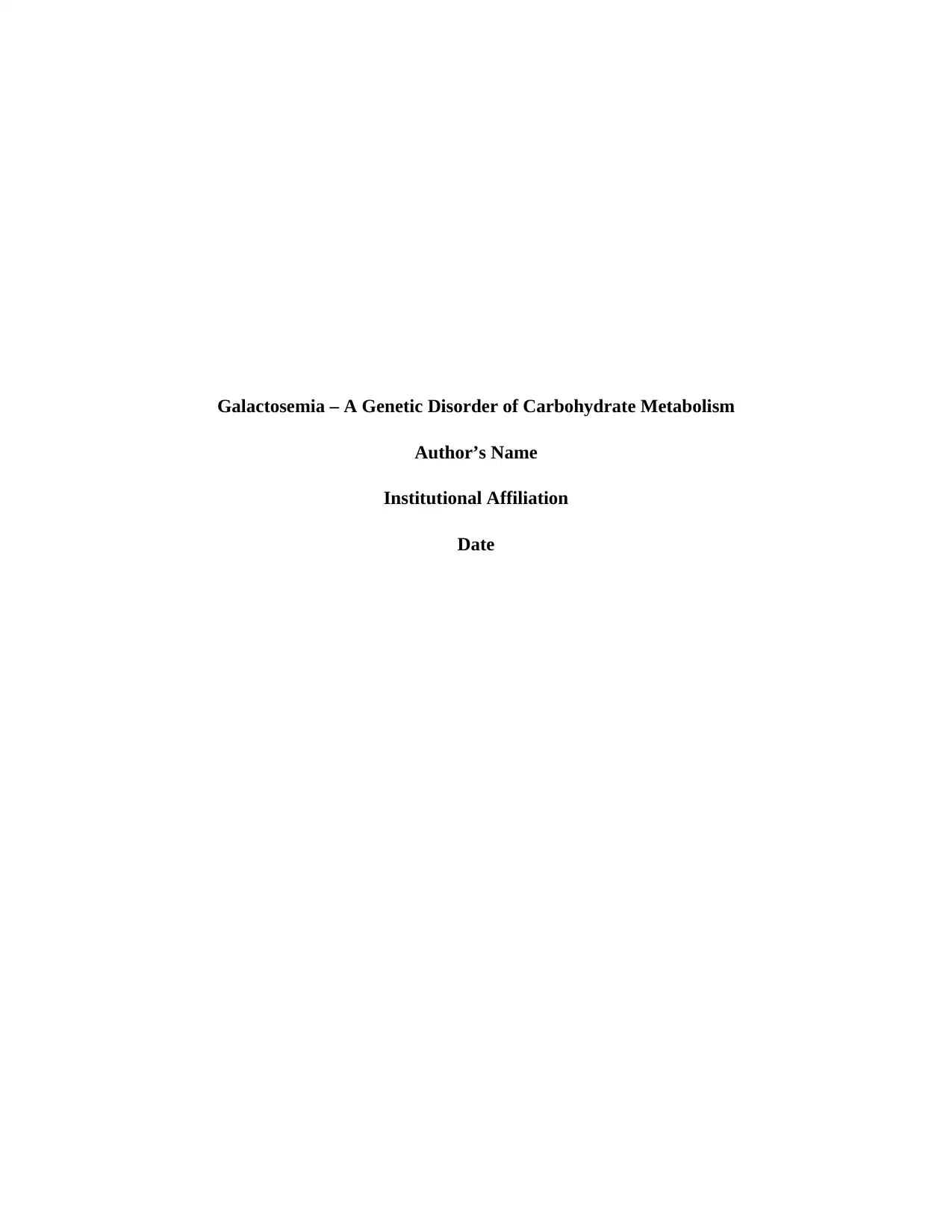
Galactosemia – A Genetic Disorder of Carbohydrate Metabolism
Author’s Name
Institutional Affiliation
Date
Author’s Name
Institutional Affiliation
Date
Secure Best Marks with AI Grader
Need help grading? Try our AI Grader for instant feedback on your assignments.
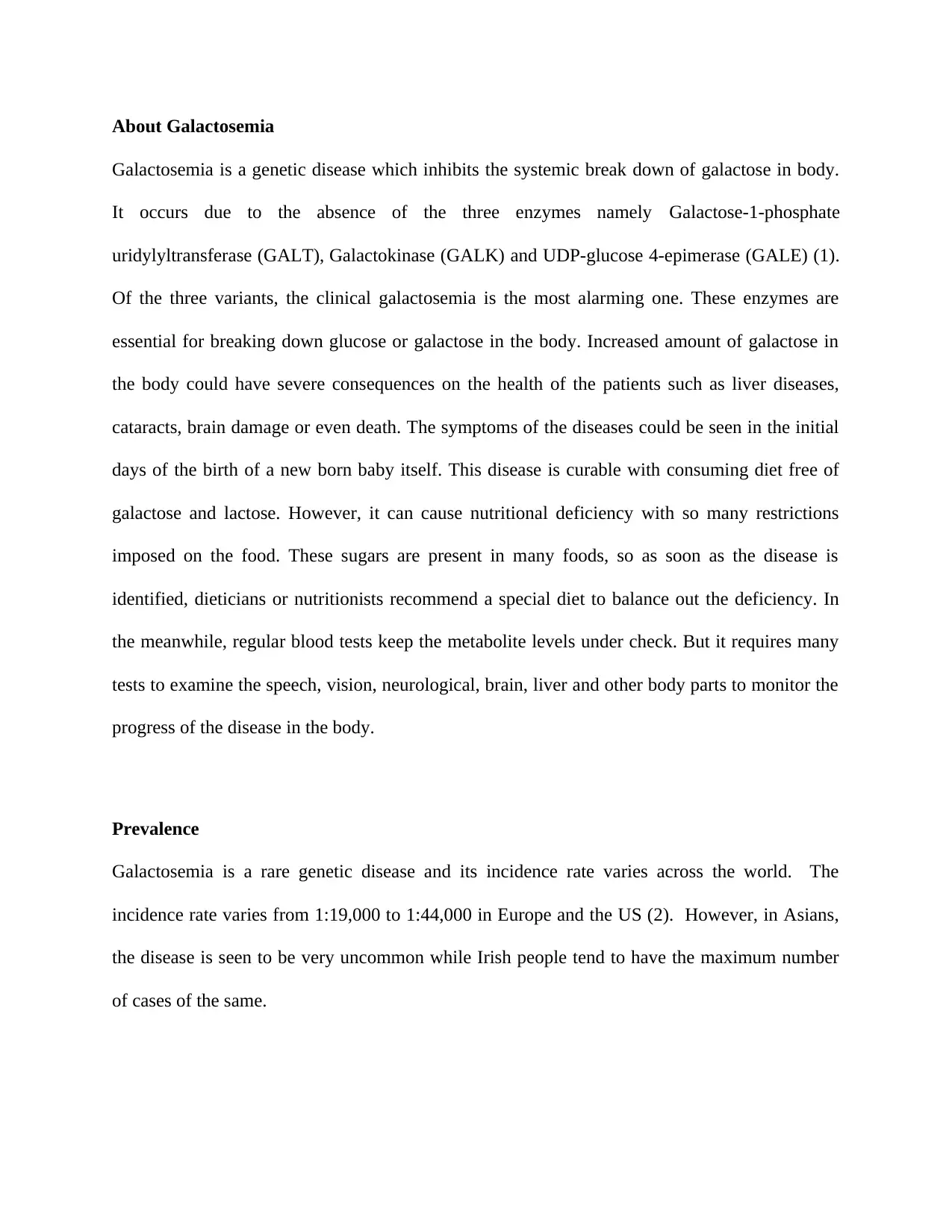
About Galactosemia
Galactosemia is a genetic disease which inhibits the systemic break down of galactose in body.
It occurs due to the absence of the three enzymes namely Galactose-1-phosphate
uridylyltransferase (GALT), Galactokinase (GALK) and UDP-glucose 4-epimerase (GALE) (1).
Of the three variants, the clinical galactosemia is the most alarming one. These enzymes are
essential for breaking down glucose or galactose in the body. Increased amount of galactose in
the body could have severe consequences on the health of the patients such as liver diseases,
cataracts, brain damage or even death. The symptoms of the diseases could be seen in the initial
days of the birth of a new born baby itself. This disease is curable with consuming diet free of
galactose and lactose. However, it can cause nutritional deficiency with so many restrictions
imposed on the food. These sugars are present in many foods, so as soon as the disease is
identified, dieticians or nutritionists recommend a special diet to balance out the deficiency. In
the meanwhile, regular blood tests keep the metabolite levels under check. But it requires many
tests to examine the speech, vision, neurological, brain, liver and other body parts to monitor the
progress of the disease in the body.
Prevalence
Galactosemia is a rare genetic disease and its incidence rate varies across the world. The
incidence rate varies from 1:19,000 to 1:44,000 in Europe and the US (2). However, in Asians,
the disease is seen to be very uncommon while Irish people tend to have the maximum number
of cases of the same.
Galactosemia is a genetic disease which inhibits the systemic break down of galactose in body.
It occurs due to the absence of the three enzymes namely Galactose-1-phosphate
uridylyltransferase (GALT), Galactokinase (GALK) and UDP-glucose 4-epimerase (GALE) (1).
Of the three variants, the clinical galactosemia is the most alarming one. These enzymes are
essential for breaking down glucose or galactose in the body. Increased amount of galactose in
the body could have severe consequences on the health of the patients such as liver diseases,
cataracts, brain damage or even death. The symptoms of the diseases could be seen in the initial
days of the birth of a new born baby itself. This disease is curable with consuming diet free of
galactose and lactose. However, it can cause nutritional deficiency with so many restrictions
imposed on the food. These sugars are present in many foods, so as soon as the disease is
identified, dieticians or nutritionists recommend a special diet to balance out the deficiency. In
the meanwhile, regular blood tests keep the metabolite levels under check. But it requires many
tests to examine the speech, vision, neurological, brain, liver and other body parts to monitor the
progress of the disease in the body.
Prevalence
Galactosemia is a rare genetic disease and its incidence rate varies across the world. The
incidence rate varies from 1:19,000 to 1:44,000 in Europe and the US (2). However, in Asians,
the disease is seen to be very uncommon while Irish people tend to have the maximum number
of cases of the same.
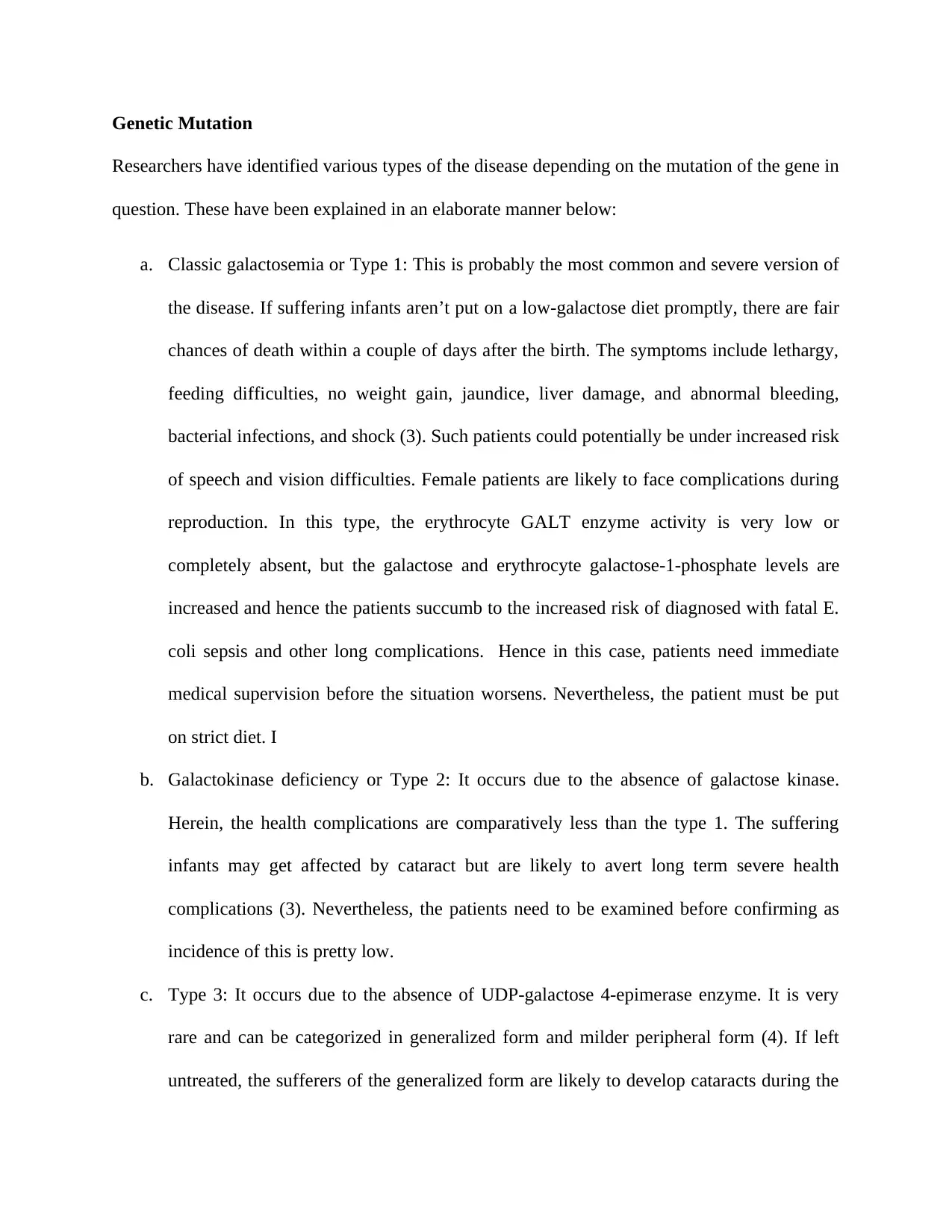
Genetic Mutation
Researchers have identified various types of the disease depending on the mutation of the gene in
question. These have been explained in an elaborate manner below:
a. Classic galactosemia or Type 1: This is probably the most common and severe version of
the disease. If suffering infants aren’t put on a low-galactose diet promptly, there are fair
chances of death within a couple of days after the birth. The symptoms include lethargy,
feeding difficulties, no weight gain, jaundice, liver damage, and abnormal bleeding,
bacterial infections, and shock (3). Such patients could potentially be under increased risk
of speech and vision difficulties. Female patients are likely to face complications during
reproduction. In this type, the erythrocyte GALT enzyme activity is very low or
completely absent, but the galactose and erythrocyte galactose-1-phosphate levels are
increased and hence the patients succumb to the increased risk of diagnosed with fatal E.
coli sepsis and other long complications. Hence in this case, patients need immediate
medical supervision before the situation worsens. Nevertheless, the patient must be put
on strict diet. I
b. Galactokinase deficiency or Type 2: It occurs due to the absence of galactose kinase.
Herein, the health complications are comparatively less than the type 1. The suffering
infants may get affected by cataract but are likely to avert long term severe health
complications (3). Nevertheless, the patients need to be examined before confirming as
incidence of this is pretty low.
c. Type 3: It occurs due to the absence of UDP-galactose 4-epimerase enzyme. It is very
rare and can be categorized in generalized form and milder peripheral form (4). If left
untreated, the sufferers of the generalized form are likely to develop cataracts during the
Researchers have identified various types of the disease depending on the mutation of the gene in
question. These have been explained in an elaborate manner below:
a. Classic galactosemia or Type 1: This is probably the most common and severe version of
the disease. If suffering infants aren’t put on a low-galactose diet promptly, there are fair
chances of death within a couple of days after the birth. The symptoms include lethargy,
feeding difficulties, no weight gain, jaundice, liver damage, and abnormal bleeding,
bacterial infections, and shock (3). Such patients could potentially be under increased risk
of speech and vision difficulties. Female patients are likely to face complications during
reproduction. In this type, the erythrocyte GALT enzyme activity is very low or
completely absent, but the galactose and erythrocyte galactose-1-phosphate levels are
increased and hence the patients succumb to the increased risk of diagnosed with fatal E.
coli sepsis and other long complications. Hence in this case, patients need immediate
medical supervision before the situation worsens. Nevertheless, the patient must be put
on strict diet. I
b. Galactokinase deficiency or Type 2: It occurs due to the absence of galactose kinase.
Herein, the health complications are comparatively less than the type 1. The suffering
infants may get affected by cataract but are likely to avert long term severe health
complications (3). Nevertheless, the patients need to be examined before confirming as
incidence of this is pretty low.
c. Type 3: It occurs due to the absence of UDP-galactose 4-epimerase enzyme. It is very
rare and can be categorized in generalized form and milder peripheral form (4). If left
untreated, the sufferers of the generalized form are likely to develop cataracts during the
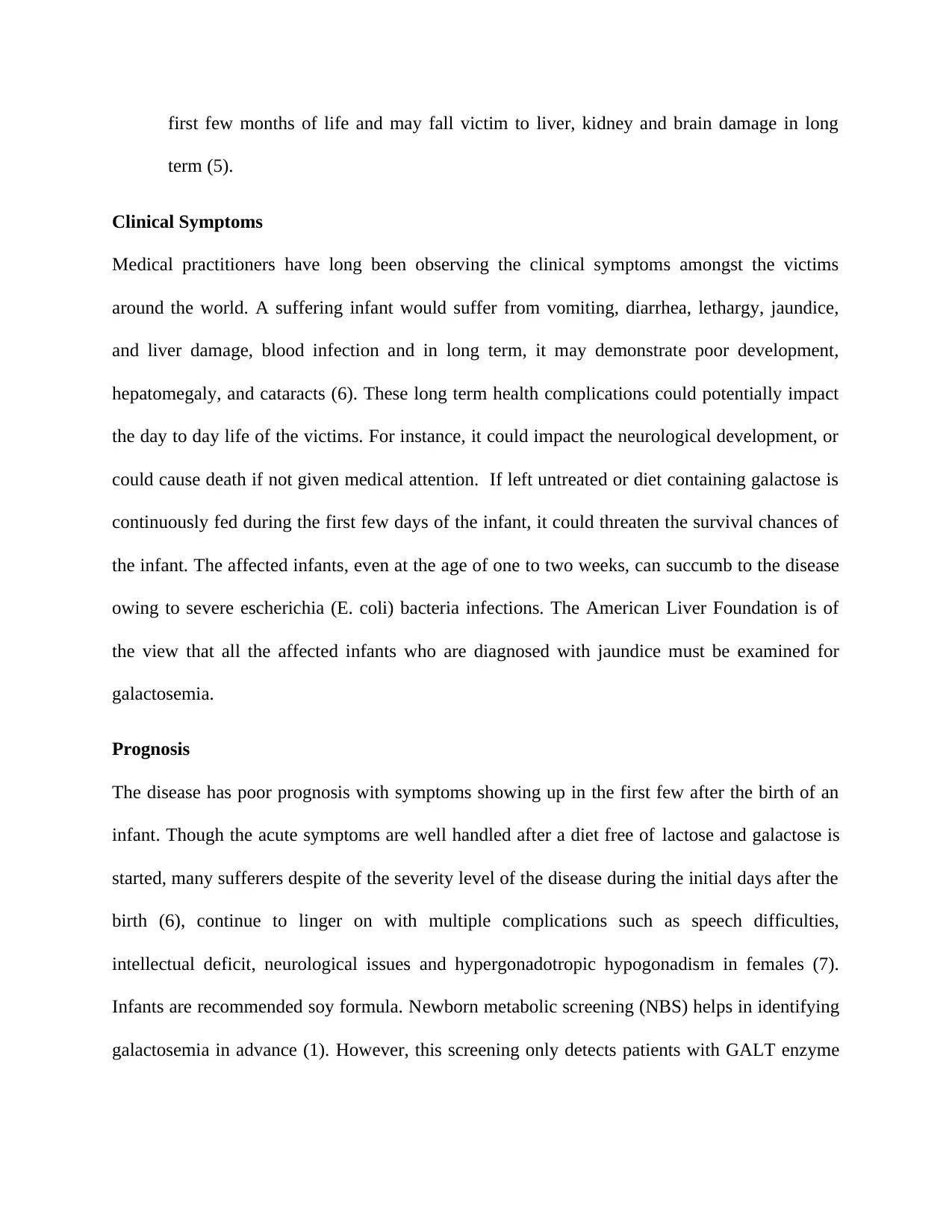
first few months of life and may fall victim to liver, kidney and brain damage in long
term (5).
Clinical Symptoms
Medical practitioners have long been observing the clinical symptoms amongst the victims
around the world. A suffering infant would suffer from vomiting, diarrhea, lethargy, jaundice,
and liver damage, blood infection and in long term, it may demonstrate poor development,
hepatomegaly, and cataracts (6). These long term health complications could potentially impact
the day to day life of the victims. For instance, it could impact the neurological development, or
could cause death if not given medical attention. If left untreated or diet containing galactose is
continuously fed during the first few days of the infant, it could threaten the survival chances of
the infant. The affected infants, even at the age of one to two weeks, can succumb to the disease
owing to severe escherichia (E. coli) bacteria infections. The American Liver Foundation is of
the view that all the affected infants who are diagnosed with jaundice must be examined for
galactosemia.
Prognosis
The disease has poor prognosis with symptoms showing up in the first few after the birth of an
infant. Though the acute symptoms are well handled after a diet free of lactose and galactose is
started, many sufferers despite of the severity level of the disease during the initial days after the
birth (6), continue to linger on with multiple complications such as speech difficulties,
intellectual deficit, neurological issues and hypergonadotropic hypogonadism in females (7).
Infants are recommended soy formula. Newborn metabolic screening (NBS) helps in identifying
galactosemia in advance (1). However, this screening only detects patients with GALT enzyme
term (5).
Clinical Symptoms
Medical practitioners have long been observing the clinical symptoms amongst the victims
around the world. A suffering infant would suffer from vomiting, diarrhea, lethargy, jaundice,
and liver damage, blood infection and in long term, it may demonstrate poor development,
hepatomegaly, and cataracts (6). These long term health complications could potentially impact
the day to day life of the victims. For instance, it could impact the neurological development, or
could cause death if not given medical attention. If left untreated or diet containing galactose is
continuously fed during the first few days of the infant, it could threaten the survival chances of
the infant. The affected infants, even at the age of one to two weeks, can succumb to the disease
owing to severe escherichia (E. coli) bacteria infections. The American Liver Foundation is of
the view that all the affected infants who are diagnosed with jaundice must be examined for
galactosemia.
Prognosis
The disease has poor prognosis with symptoms showing up in the first few after the birth of an
infant. Though the acute symptoms are well handled after a diet free of lactose and galactose is
started, many sufferers despite of the severity level of the disease during the initial days after the
birth (6), continue to linger on with multiple complications such as speech difficulties,
intellectual deficit, neurological issues and hypergonadotropic hypogonadism in females (7).
Infants are recommended soy formula. Newborn metabolic screening (NBS) helps in identifying
galactosemia in advance (1). However, this screening only detects patients with GALT enzyme
Secure Best Marks with AI Grader
Need help grading? Try our AI Grader for instant feedback on your assignments.
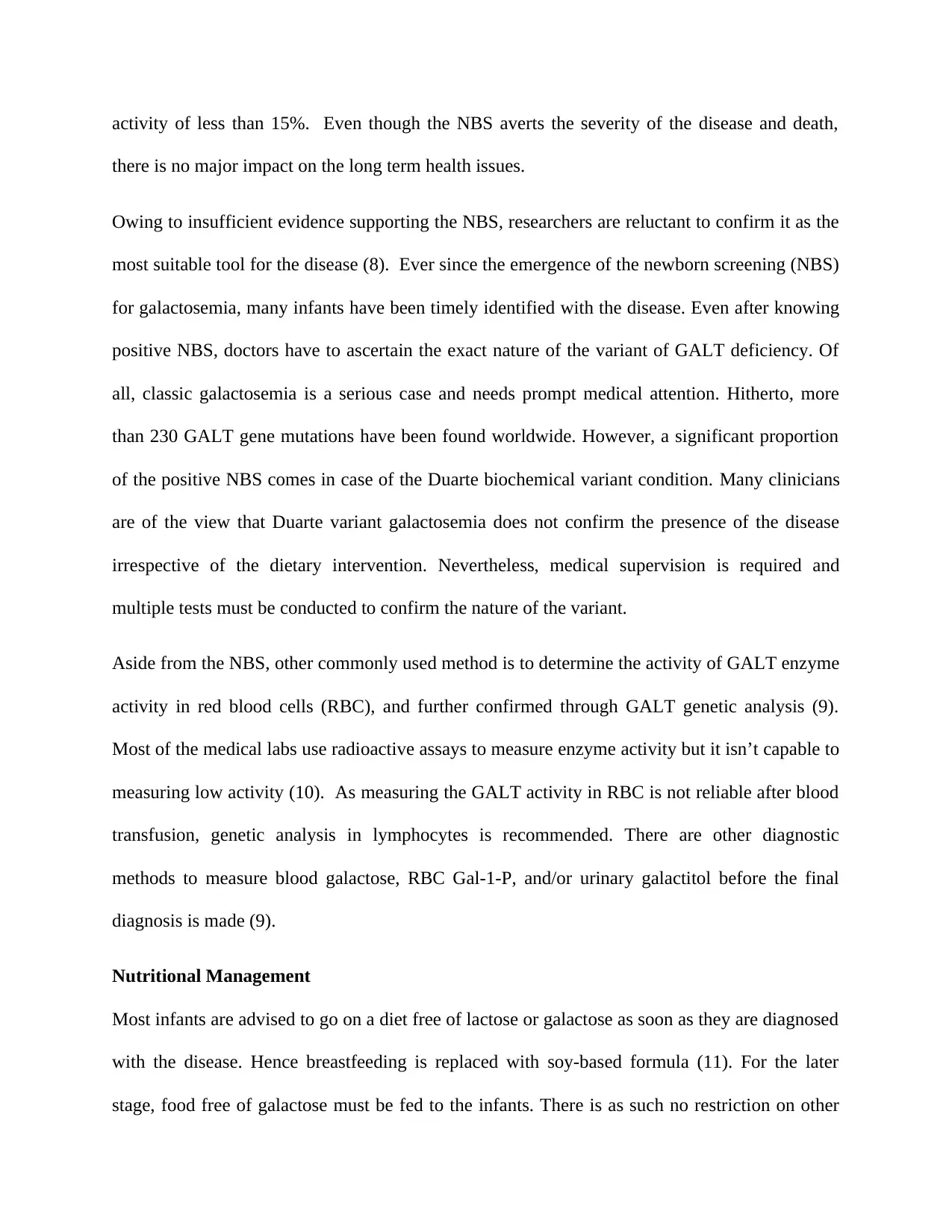
activity of less than 15%. Even though the NBS averts the severity of the disease and death,
there is no major impact on the long term health issues.
Owing to insufficient evidence supporting the NBS, researchers are reluctant to confirm it as the
most suitable tool for the disease (8). Ever since the emergence of the newborn screening (NBS)
for galactosemia, many infants have been timely identified with the disease. Even after knowing
positive NBS, doctors have to ascertain the exact nature of the variant of GALT deficiency. Of
all, classic galactosemia is a serious case and needs prompt medical attention. Hitherto, more
than 230 GALT gene mutations have been found worldwide. However, a significant proportion
of the positive NBS comes in case of the Duarte biochemical variant condition. Many clinicians
are of the view that Duarte variant galactosemia does not confirm the presence of the disease
irrespective of the dietary intervention. Nevertheless, medical supervision is required and
multiple tests must be conducted to confirm the nature of the variant.
Aside from the NBS, other commonly used method is to determine the activity of GALT enzyme
activity in red blood cells (RBC), and further confirmed through GALT genetic analysis (9).
Most of the medical labs use radioactive assays to measure enzyme activity but it isn’t capable to
measuring low activity (10). As measuring the GALT activity in RBC is not reliable after blood
transfusion, genetic analysis in lymphocytes is recommended. There are other diagnostic
methods to measure blood galactose, RBC Gal-1-P, and/or urinary galactitol before the final
diagnosis is made (9).
Nutritional Management
Most infants are advised to go on a diet free of lactose or galactose as soon as they are diagnosed
with the disease. Hence breastfeeding is replaced with soy-based formula (11). For the later
stage, food free of galactose must be fed to the infants. There is as such no restriction on other
there is no major impact on the long term health issues.
Owing to insufficient evidence supporting the NBS, researchers are reluctant to confirm it as the
most suitable tool for the disease (8). Ever since the emergence of the newborn screening (NBS)
for galactosemia, many infants have been timely identified with the disease. Even after knowing
positive NBS, doctors have to ascertain the exact nature of the variant of GALT deficiency. Of
all, classic galactosemia is a serious case and needs prompt medical attention. Hitherto, more
than 230 GALT gene mutations have been found worldwide. However, a significant proportion
of the positive NBS comes in case of the Duarte biochemical variant condition. Many clinicians
are of the view that Duarte variant galactosemia does not confirm the presence of the disease
irrespective of the dietary intervention. Nevertheless, medical supervision is required and
multiple tests must be conducted to confirm the nature of the variant.
Aside from the NBS, other commonly used method is to determine the activity of GALT enzyme
activity in red blood cells (RBC), and further confirmed through GALT genetic analysis (9).
Most of the medical labs use radioactive assays to measure enzyme activity but it isn’t capable to
measuring low activity (10). As measuring the GALT activity in RBC is not reliable after blood
transfusion, genetic analysis in lymphocytes is recommended. There are other diagnostic
methods to measure blood galactose, RBC Gal-1-P, and/or urinary galactitol before the final
diagnosis is made (9).
Nutritional Management
Most infants are advised to go on a diet free of lactose or galactose as soon as they are diagnosed
with the disease. Hence breastfeeding is replaced with soy-based formula (11). For the later
stage, food free of galactose must be fed to the infants. There is as such no restriction on other
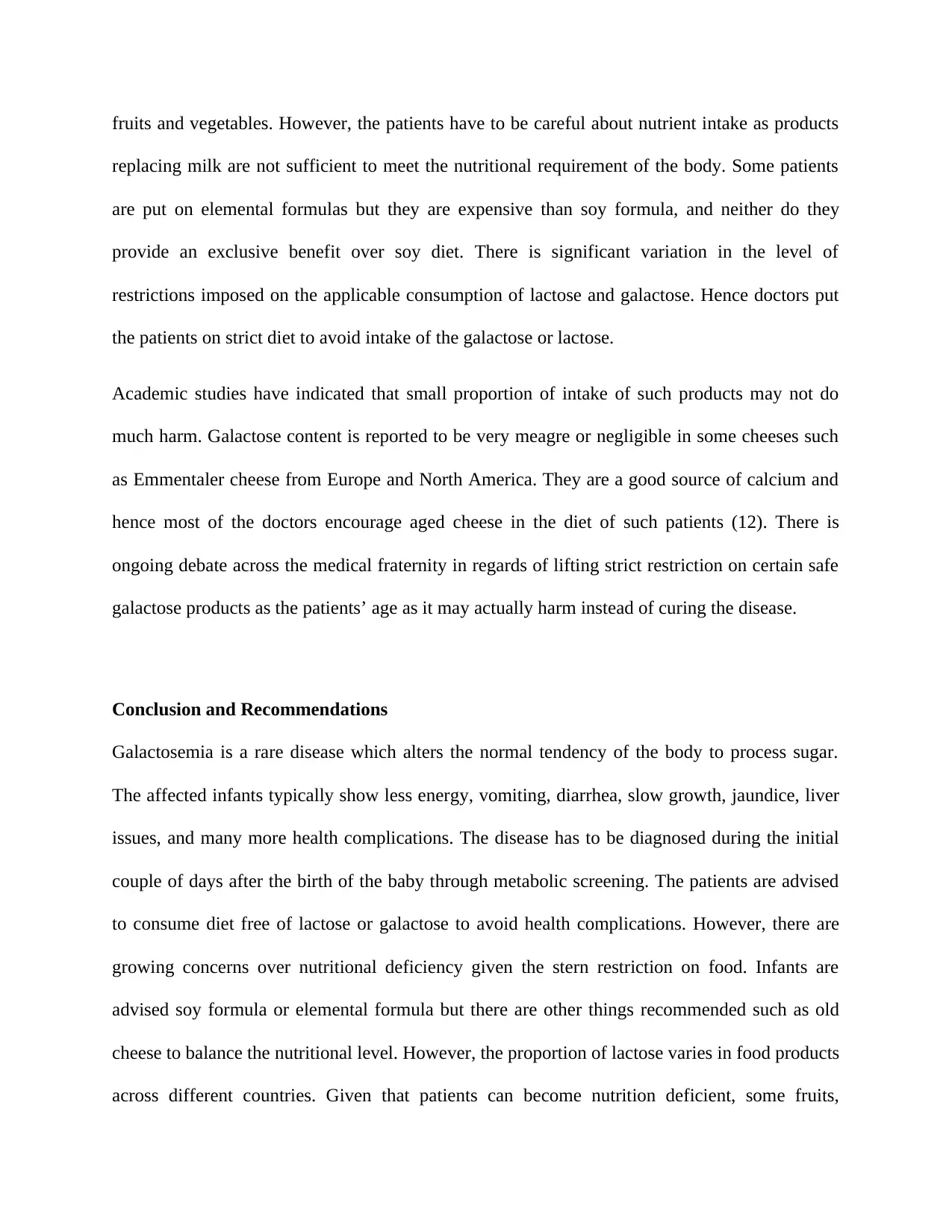
fruits and vegetables. However, the patients have to be careful about nutrient intake as products
replacing milk are not sufficient to meet the nutritional requirement of the body. Some patients
are put on elemental formulas but they are expensive than soy formula, and neither do they
provide an exclusive benefit over soy diet. There is significant variation in the level of
restrictions imposed on the applicable consumption of lactose and galactose. Hence doctors put
the patients on strict diet to avoid intake of the galactose or lactose.
Academic studies have indicated that small proportion of intake of such products may not do
much harm. Galactose content is reported to be very meagre or negligible in some cheeses such
as Emmentaler cheese from Europe and North America. They are a good source of calcium and
hence most of the doctors encourage aged cheese in the diet of such patients (12). There is
ongoing debate across the medical fraternity in regards of lifting strict restriction on certain safe
galactose products as the patients’ age as it may actually harm instead of curing the disease.
Conclusion and Recommendations
Galactosemia is a rare disease which alters the normal tendency of the body to process sugar.
The affected infants typically show less energy, vomiting, diarrhea, slow growth, jaundice, liver
issues, and many more health complications. The disease has to be diagnosed during the initial
couple of days after the birth of the baby through metabolic screening. The patients are advised
to consume diet free of lactose or galactose to avoid health complications. However, there are
growing concerns over nutritional deficiency given the stern restriction on food. Infants are
advised soy formula or elemental formula but there are other things recommended such as old
cheese to balance the nutritional level. However, the proportion of lactose varies in food products
across different countries. Given that patients can become nutrition deficient, some fruits,
replacing milk are not sufficient to meet the nutritional requirement of the body. Some patients
are put on elemental formulas but they are expensive than soy formula, and neither do they
provide an exclusive benefit over soy diet. There is significant variation in the level of
restrictions imposed on the applicable consumption of lactose and galactose. Hence doctors put
the patients on strict diet to avoid intake of the galactose or lactose.
Academic studies have indicated that small proportion of intake of such products may not do
much harm. Galactose content is reported to be very meagre or negligible in some cheeses such
as Emmentaler cheese from Europe and North America. They are a good source of calcium and
hence most of the doctors encourage aged cheese in the diet of such patients (12). There is
ongoing debate across the medical fraternity in regards of lifting strict restriction on certain safe
galactose products as the patients’ age as it may actually harm instead of curing the disease.
Conclusion and Recommendations
Galactosemia is a rare disease which alters the normal tendency of the body to process sugar.
The affected infants typically show less energy, vomiting, diarrhea, slow growth, jaundice, liver
issues, and many more health complications. The disease has to be diagnosed during the initial
couple of days after the birth of the baby through metabolic screening. The patients are advised
to consume diet free of lactose or galactose to avoid health complications. However, there are
growing concerns over nutritional deficiency given the stern restriction on food. Infants are
advised soy formula or elemental formula but there are other things recommended such as old
cheese to balance the nutritional level. However, the proportion of lactose varies in food products
across different countries. Given that patients can become nutrition deficient, some fruits,
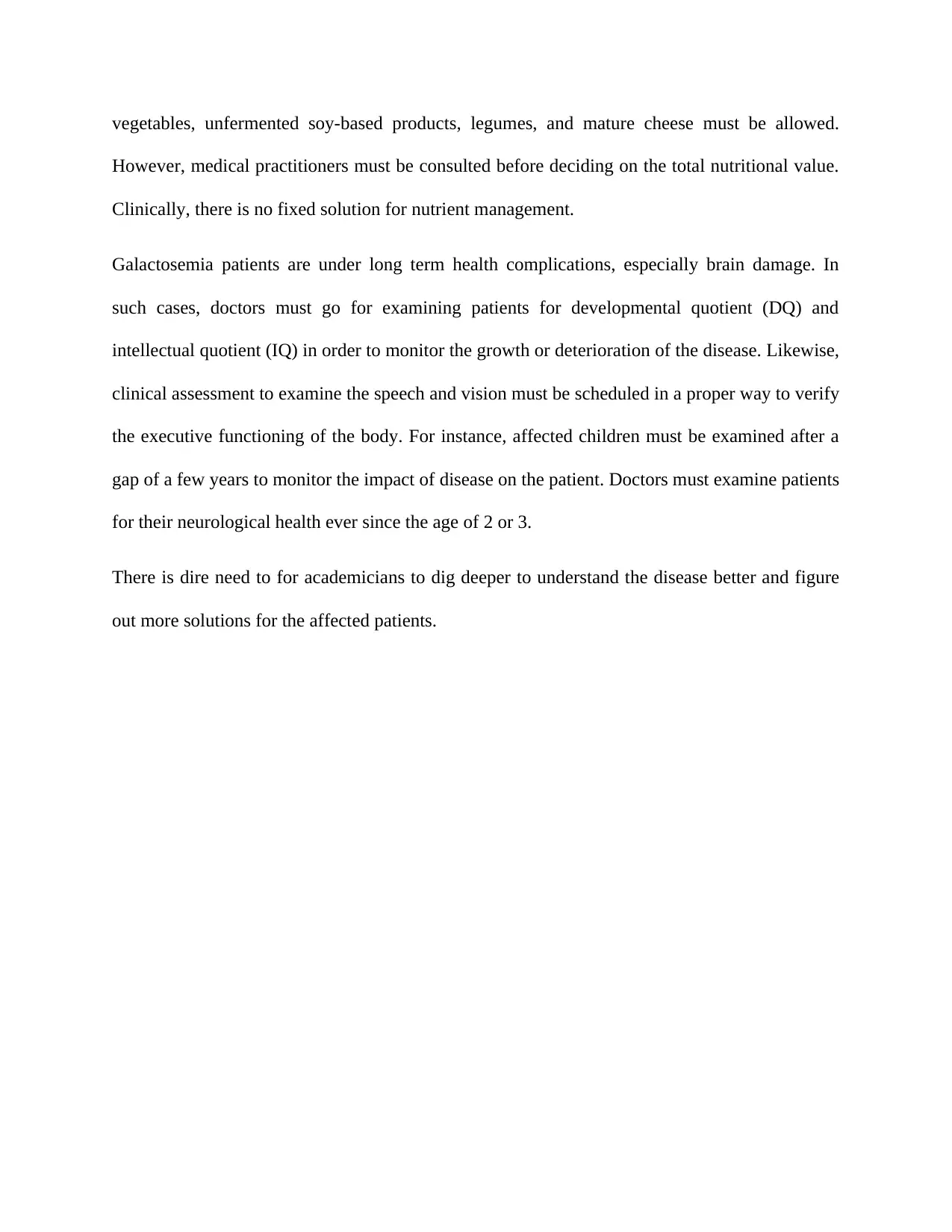
vegetables, unfermented soy-based products, legumes, and mature cheese must be allowed.
However, medical practitioners must be consulted before deciding on the total nutritional value.
Clinically, there is no fixed solution for nutrient management.
Galactosemia patients are under long term health complications, especially brain damage. In
such cases, doctors must go for examining patients for developmental quotient (DQ) and
intellectual quotient (IQ) in order to monitor the growth or deterioration of the disease. Likewise,
clinical assessment to examine the speech and vision must be scheduled in a proper way to verify
the executive functioning of the body. For instance, affected children must be examined after a
gap of a few years to monitor the impact of disease on the patient. Doctors must examine patients
for their neurological health ever since the age of 2 or 3.
There is dire need to for academicians to dig deeper to understand the disease better and figure
out more solutions for the affected patients.
However, medical practitioners must be consulted before deciding on the total nutritional value.
Clinically, there is no fixed solution for nutrient management.
Galactosemia patients are under long term health complications, especially brain damage. In
such cases, doctors must go for examining patients for developmental quotient (DQ) and
intellectual quotient (IQ) in order to monitor the growth or deterioration of the disease. Likewise,
clinical assessment to examine the speech and vision must be scheduled in a proper way to verify
the executive functioning of the body. For instance, affected children must be examined after a
gap of a few years to monitor the impact of disease on the patient. Doctors must examine patients
for their neurological health ever since the age of 2 or 3.
There is dire need to for academicians to dig deeper to understand the disease better and figure
out more solutions for the affected patients.
Paraphrase This Document
Need a fresh take? Get an instant paraphrase of this document with our AI Paraphraser
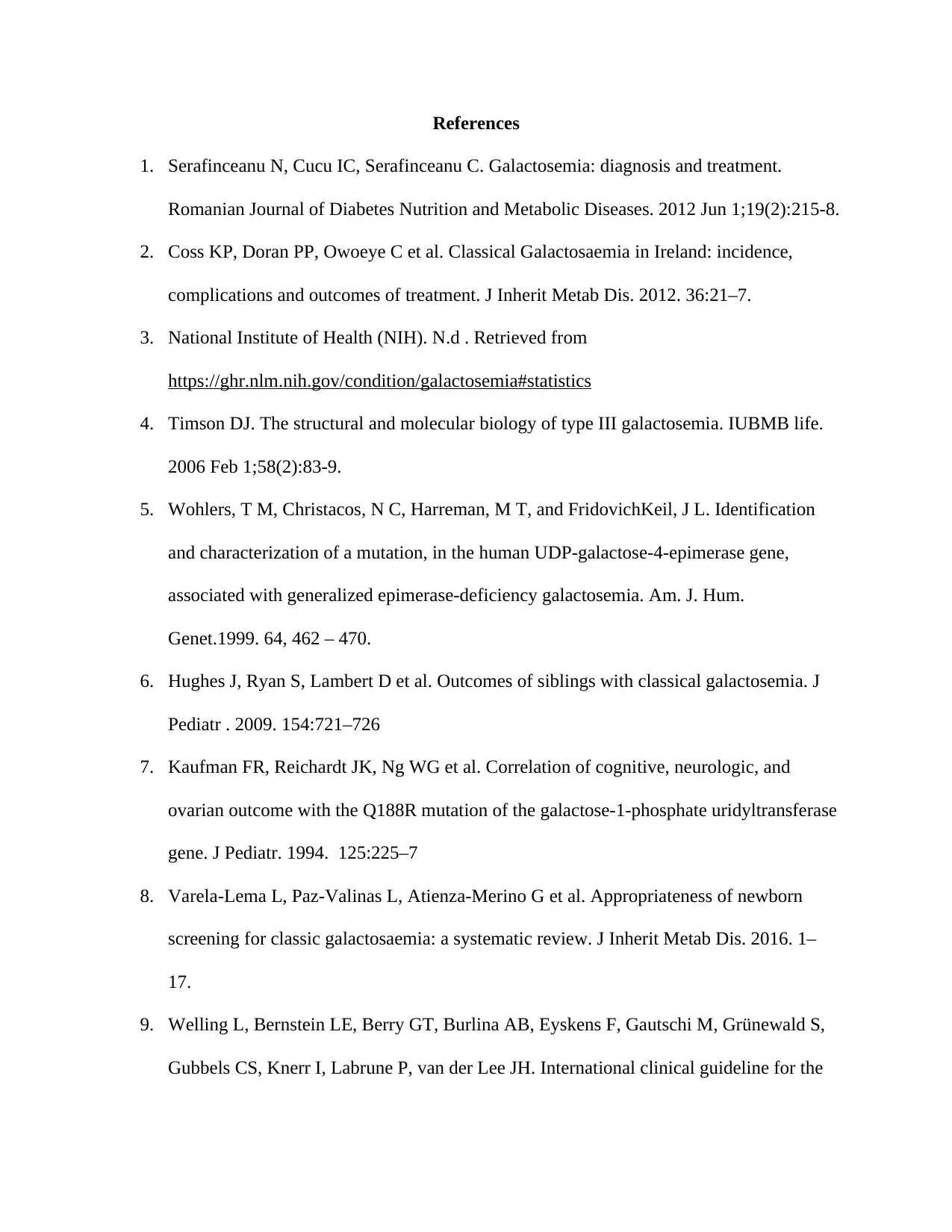
References
1. Serafinceanu N, Cucu IC, Serafinceanu C. Galactosemia: diagnosis and treatment.
Romanian Journal of Diabetes Nutrition and Metabolic Diseases. 2012 Jun 1;19(2):215-8.
2. Coss KP, Doran PP, Owoeye C et al. Classical Galactosaemia in Ireland: incidence,
complications and outcomes of treatment. J Inherit Metab Dis. 2012. 36:21–7.
3. National Institute of Health (NIH). N.d . Retrieved from
https://ghr.nlm.nih.gov/condition/galactosemia#statistics
4. Timson DJ. The structural and molecular biology of type III galactosemia. IUBMB life.
2006 Feb 1;58(2):83-9.
5. Wohlers, T M, Christacos, N C, Harreman, M T, and FridovichKeil, J L. Identification
and characterization of a mutation, in the human UDP-galactose-4-epimerase gene,
associated with generalized epimerase-deficiency galactosemia. Am. J. Hum.
Genet.1999. 64, 462 – 470.
6. Hughes J, Ryan S, Lambert D et al. Outcomes of siblings with classical galactosemia. J
Pediatr . 2009. 154:721–726
7. Kaufman FR, Reichardt JK, Ng WG et al. Correlation of cognitive, neurologic, and
ovarian outcome with the Q188R mutation of the galactose-1-phosphate uridyltransferase
gene. J Pediatr. 1994. 125:225–7
8. Varela-Lema L, Paz-Valinas L, Atienza-Merino G et al. Appropriateness of newborn
screening for classic galactosaemia: a systematic review. J Inherit Metab Dis. 2016. 1–
17.
9. Welling L, Bernstein LE, Berry GT, Burlina AB, Eyskens F, Gautschi M, Grünewald S,
Gubbels CS, Knerr I, Labrune P, van der Lee JH. International clinical guideline for the
1. Serafinceanu N, Cucu IC, Serafinceanu C. Galactosemia: diagnosis and treatment.
Romanian Journal of Diabetes Nutrition and Metabolic Diseases. 2012 Jun 1;19(2):215-8.
2. Coss KP, Doran PP, Owoeye C et al. Classical Galactosaemia in Ireland: incidence,
complications and outcomes of treatment. J Inherit Metab Dis. 2012. 36:21–7.
3. National Institute of Health (NIH). N.d . Retrieved from
https://ghr.nlm.nih.gov/condition/galactosemia#statistics
4. Timson DJ. The structural and molecular biology of type III galactosemia. IUBMB life.
2006 Feb 1;58(2):83-9.
5. Wohlers, T M, Christacos, N C, Harreman, M T, and FridovichKeil, J L. Identification
and characterization of a mutation, in the human UDP-galactose-4-epimerase gene,
associated with generalized epimerase-deficiency galactosemia. Am. J. Hum.
Genet.1999. 64, 462 – 470.
6. Hughes J, Ryan S, Lambert D et al. Outcomes of siblings with classical galactosemia. J
Pediatr . 2009. 154:721–726
7. Kaufman FR, Reichardt JK, Ng WG et al. Correlation of cognitive, neurologic, and
ovarian outcome with the Q188R mutation of the galactose-1-phosphate uridyltransferase
gene. J Pediatr. 1994. 125:225–7
8. Varela-Lema L, Paz-Valinas L, Atienza-Merino G et al. Appropriateness of newborn
screening for classic galactosaemia: a systematic review. J Inherit Metab Dis. 2016. 1–
17.
9. Welling L, Bernstein LE, Berry GT, Burlina AB, Eyskens F, Gautschi M, Grünewald S,
Gubbels CS, Knerr I, Labrune P, van der Lee JH. International clinical guideline for the
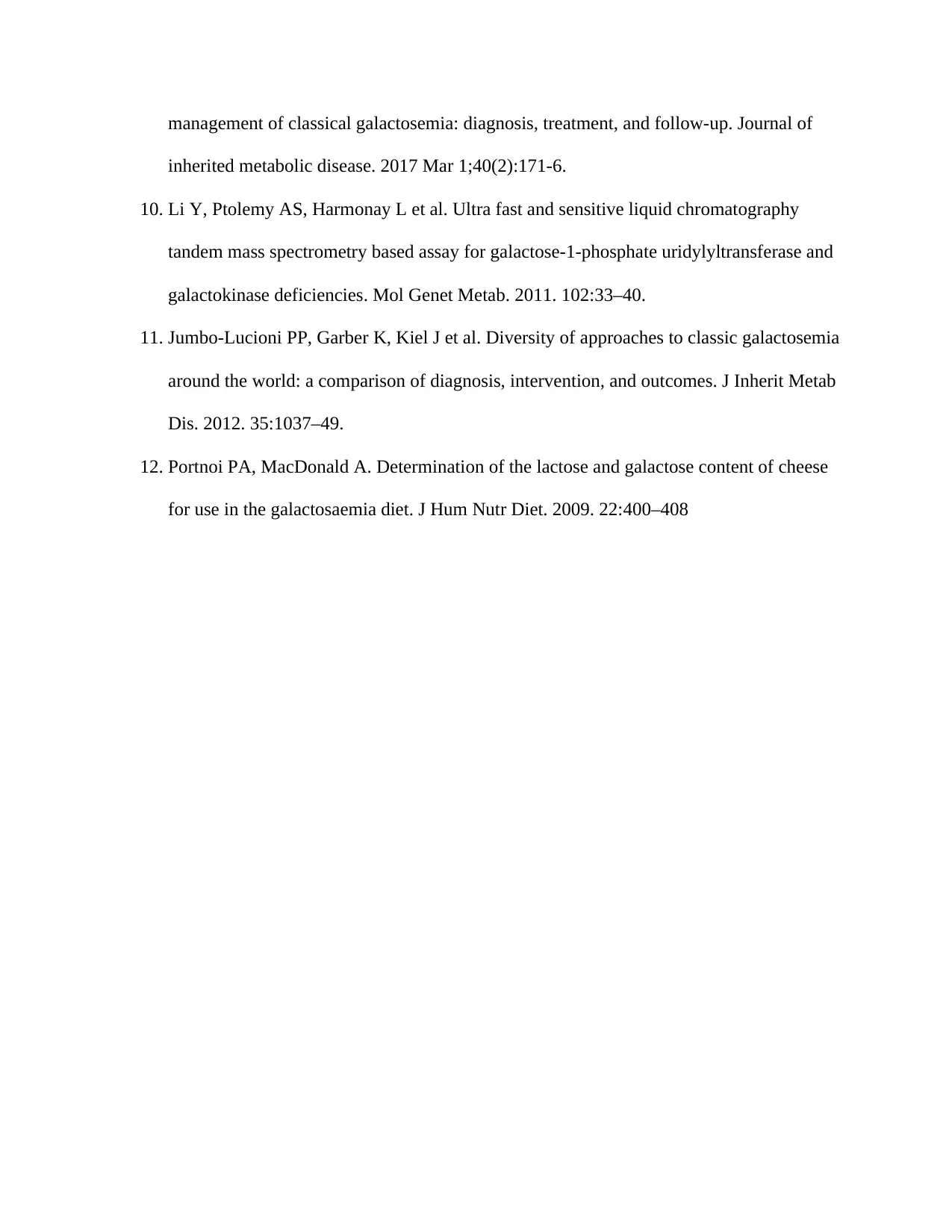
management of classical galactosemia: diagnosis, treatment, and follow-up. Journal of
inherited metabolic disease. 2017 Mar 1;40(2):171-6.
10. Li Y, Ptolemy AS, Harmonay L et al. Ultra fast and sensitive liquid chromatography
tandem mass spectrometry based assay for galactose-1-phosphate uridylyltransferase and
galactokinase deficiencies. Mol Genet Metab. 2011. 102:33–40.
11. Jumbo-Lucioni PP, Garber K, Kiel J et al. Diversity of approaches to classic galactosemia
around the world: a comparison of diagnosis, intervention, and outcomes. J Inherit Metab
Dis. 2012. 35:1037–49.
12. Portnoi PA, MacDonald A. Determination of the lactose and galactose content of cheese
for use in the galactosaemia diet. J Hum Nutr Diet. 2009. 22:400–408
inherited metabolic disease. 2017 Mar 1;40(2):171-6.
10. Li Y, Ptolemy AS, Harmonay L et al. Ultra fast and sensitive liquid chromatography
tandem mass spectrometry based assay for galactose-1-phosphate uridylyltransferase and
galactokinase deficiencies. Mol Genet Metab. 2011. 102:33–40.
11. Jumbo-Lucioni PP, Garber K, Kiel J et al. Diversity of approaches to classic galactosemia
around the world: a comparison of diagnosis, intervention, and outcomes. J Inherit Metab
Dis. 2012. 35:1037–49.
12. Portnoi PA, MacDonald A. Determination of the lactose and galactose content of cheese
for use in the galactosaemia diet. J Hum Nutr Diet. 2009. 22:400–408
1 out of 9
Related Documents
Your All-in-One AI-Powered Toolkit for Academic Success.
+13062052269
info@desklib.com
Available 24*7 on WhatsApp / Email
![[object Object]](/_next/static/media/star-bottom.7253800d.svg)
Unlock your academic potential
© 2024 | Zucol Services PVT LTD | All rights reserved.





